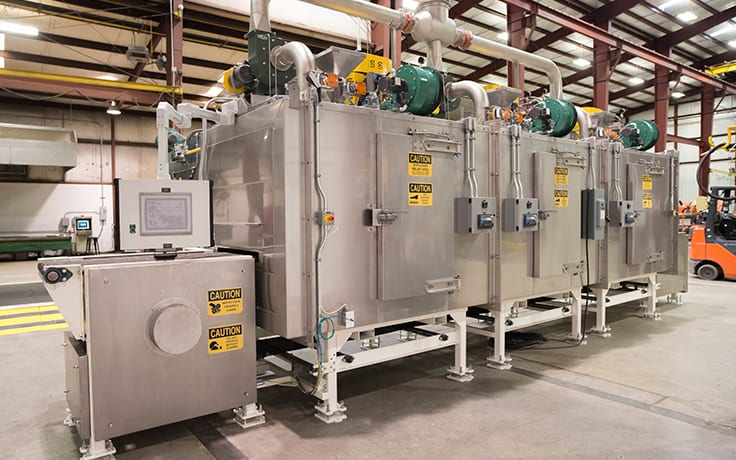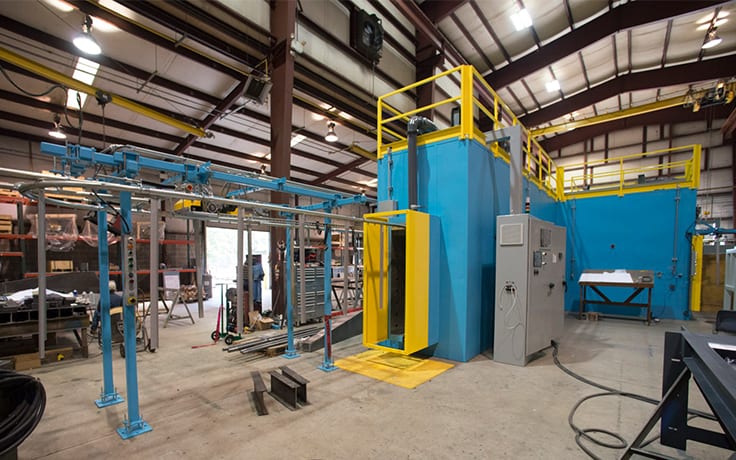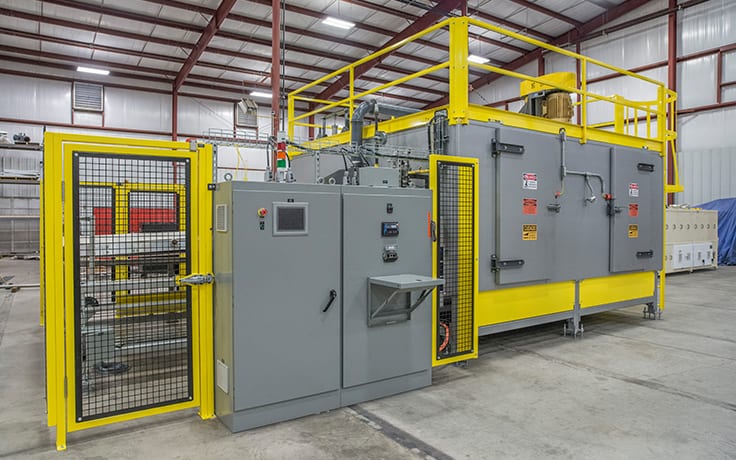Specifying any piece of industrial thermal processing equipment should come with a warning.
“Don’t half-bake.”
Industrial conveyor ovens only work well when products, processes and people are pointed in the same direction.
For process engineers or facility leaders buying conveyor ovens for the first time, understanding the following eight critical concepts will help you specify the most precise, most efficient and most productive system.
#1 – Understanding oven types
“Industrial ovens” is a broad category. Within it are two primary types: continuous and indexing.
Continuous ovens rely on conveyors in constant motion to carry parts through a heated chamber at a speed programmed to achieve a desired thermal result within the specified production rate. Continuous ovens are best for high-volume processing of the same or similar parts and work well in conjunction with either manual or automated part loading.
Indexing ovens move single parts or batches of parts through thermal process stages in successive stop-and-go movements. They work best in more complicated operations in which parts must be treated in multiple zones each with a different temperature.

#2 – Choosing the right heat source
Similarly, “heating” is also a broad concept. Heat can be generated and delivered to products in many ways. Sometimes you can choose freely among them. Other times, product characteristics and desired process outcomes will lead you to the source that makes the most sense.
Electric heating is generated by running electrical current through heating elements. It can be delivered via natural convection, forced air convection or through contact surfaces.
Natural gas heating comes from the burning of — you guessed it — natural gases, such as clean-burning propane. Natural or forced air convection are the most common delivery methods.
Radiant/infrared (IR) heat refers to the electromagnetic energy given off by lights. This energy travels on its own without relying on the dynamic properties of the environment.
Note whether your oven manufacturer steers you toward a certain heating method based on their preference rather than on your product or process requirements. That’s a bright red flag.
To get better at spotting it, read our in-depth article on thermal process heating methods.
#3 – Process temperature requirements
This guidance might seem simple at first: Identify the minimum and maximum temperatures of a process in your oven spec.
It’s not.
It’s no guarantee that the min/max you hav in mind is feasible. For instance, a set point of 700 degrees Fahrenheit ±0.5 degrees might be ideal on paper, but there’s not a system in production today that can actually achieve such a tight tolerance.
That same set point with ±100 degrees of play is just as unworkable. It’s a recipe for an inconsistent finished product.
Work with your oven manufacturer to figure out a min/max that they can deliver while meeting your requirements. And if you can’t close the gap, go back to the drawing board. And bring your oven engineer with you.

#4 – Understanding heating and cooling profiles
Probably the most important information in a conveyor oven specification is the heating and cooling profiles of the products being processed.
Heating profile is the way a product is brought to its required treatment temperature. Simple processes might only require that parts at ambient temperature enter a single oven zone set to a temperature that doesn’t change for the duration of a cycle. More complicated indexing process might be necessary if a part must ramp up to and then soak at different temperatures.
Like we said at the top, don’t half-bake a specification. The clarity you provide can make or break a project.
Cooling profile refers to the way products return to ambient conditions after heating. Cooling is as rudimentary or complex as heating, depending on the application. In some cases, the cooling profile only matters to the extent that a part must reach a safe temperature for handling. In more complicated processes, parts may not achieve their desired characteristics unless cooling is tightly controlled.
That might mean additional equipment is necessary to allow parts to cool more slowly than what the ambient environment can accomplish on its own — or far more quickly.
Again, clarity on cooling profiles is essential in an oven spec.
#5 – What to know about airflow
In many industrial thermal processes, airflow is just as important as temperature. Consider these questions:
- Is your part solid or permeable?
- Will a part’s shape impact the way air flows to, through or around it?
- Does your part include adhesives or other materials that must be activated during thermal processing?
- How far must heat penetrate the product?
- Must the heat flow through a part in one direction or multiple?
- Are you having difficulty with an existing oven because its airflow characteristics aren’t right for the product being treated?
Mass airflow requirements can be as hard to understand and specify as heating and cooling profiles, so lean on your oven provider for help. Explain what your product is made of and describe the other processes that occur after thermal processing. The right partner will know how to use that intel to design the ideal mass airflow characteristics into your conveyor oven.
We explain industrial oven mass airflow considerations in much more detail in this article.
#6 – Conveyor system options
It’s called a “conveyor oven” but there are A LOT of ways to convey workpieces. The ideal mode of transport will depend on the shape, size, weight and makeup of your part as well as variables like production rate, process temperature and available space.
Conveying systems which are oriented horizontally are the most common in industry. But special process requirements or limitations due to adjacent equipment or space constraints might require monorail/overhead conveying, incline conveying or even spiral conveying.
Conveyor belts can vary widely depending on your process requirements. They can be made of flat wire, wire mesh, rubber, Teflon or other solid materials. Some incorporate trays and still others are flighted to move products up or down in elevation.
Rollers are a familiar substitute for conveyor belts. Process requirements will determine whether rollers are a viable solution instead of a belt. Part makeup and process parameters will inform whether rollers are made of metal alloys, coated metal, plastic or other materials.
Is your provider willing to consider outside-the-box conveyor solutions? Are you?
The best solutions require open minds all around.

#7 – Know your facility
The questions below might seem basic but if they’re not answered, there will be costly (and embarrassing) problems.
Will a truck with your new oven strapped to it fit into the door to your facility? If it won’t, will the oven need to arrive in pieces and be reassembled?
Will the oven fit in the space you allocated for it?
Have you figured out how and where operators will interact with the system? Will it be safe?
Is your facility’s operating voltage adequate for the machine?
Is the floor in your facility strong enough to support the oven?
There’s a hundred more questions you could ask, but you get the point. Don’t lose sight of the forest for the trees.
#8 – Your product is your guide
We mentioned it once before, but it bears repeating: Tell your oven provider as much as you can about your product.
All of the characteristics below are essential to know:
- Materials that make up the product, and their properties when heated (for example, is it flammable?)
- The product’s end use
- The manufacturing steps that occur before and after thermal processing
- The way the product is stored prior to processing
- The way the product will be loaded into the oven
- The product’s weight
- The product’s dimensions
The better your manufacturer knows your product, the better the result they deliver. It all starts with the spec.
Good guidance helps you get it right
Specifying conveyor ovens can be daunting, especially if they’re a new addition to your facility.
If you’re looking for guidance as you draw up the specs, you’re probably a great candidate for industrial oven pre-engineering. It takes the mystery out of early project planning and replaces it with clear answers and hard facts.
To get started, tell us more about what you’re planning.






